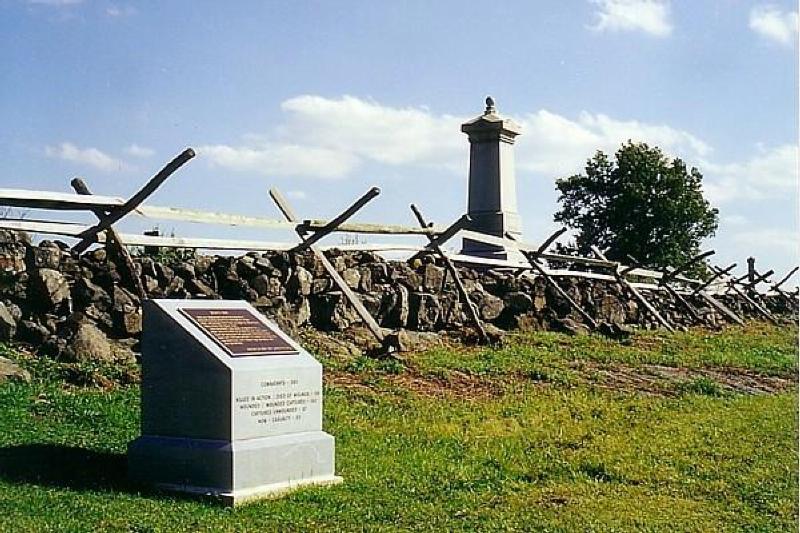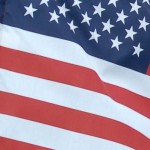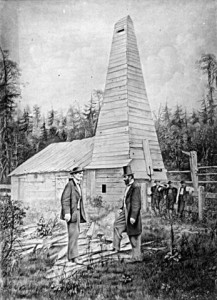The Pennsylvania Evening Post in 1775 became the first newspaper to be published in the United States. Benjamin Towne printed the newspaper in Philadelphia, Pennsylvania. The newspaper closed in 1784.

Stone Wall on Cemetery Ridge
The Battle of Gettysburg began in 1863. Many experts call this battle the turning point of the Civil War. Confederate General Robert E. Lee led his troops across the Mason-Dixon Line, heading for Harrisburg, Pennsylvania. However, the northern troops, led by General George Mead, met the Confederate troops at Gettysburg. The battle lasted for three days. On the last day of the battle, the rebel troops commenced Picket’s Charge. Fifteen thousand troops tried to assail the Union’s position. The northern troops held, and Lee lost the battle. Idea: Children could make a timeline of the battle. Michael Shaara’s book, Killer Angels, offers in-depth looks at the people fighting on both sides. Children could visit a website at: http://www.nps.gov/gett/index.htm.
 Declaration of Independence was read publicly for the first time in Philadelphia, Pennsylvania, in 1776 by Colonel John Nixon. The Liberty Bell tolled to bring citizens to hear the reading. Children can read a copy of the Declaration of Independence at: Declaration.
Declaration of Independence was read publicly for the first time in Philadelphia, Pennsylvania, in 1776 by Colonel John Nixon. The Liberty Bell tolled to bring citizens to hear the reading. Children can read a copy of the Declaration of Independence at: Declaration.

Liberty Bell
Courtesy Bev Sikes
Liberty Bell cracked in Philadelphia, Pennsylvania, for the second time in 1835. It was ringing to mark the funeral of Chief Justice John Marshall. The 2080-pound bell was originally cast in England in 1752. However, it cracked soon after arrival. The bell’s metal was melted and re-cast in 1753. Children can learn more at: Liberty Bell.
James Smith, signer of the Declaration of Independence, died in 1806. He represented Pennsylvania. His exact date of birth is unknown, but he was born in Ireland around 1719. A fire in 1803 destroyed many documents by and about Smith, so little is known about him. Children could learn more at: James Smith.
Thomas FitzSimons died in 1811 in Philadelphia, Pennsylvania. His exact date of birth is unknown. He was a delegate from Pennsylvania to the Constitutional Convention. Once wealthy, he contributed to the Revolutionary War. However, by 1805 he was bankrupt. Children can learn more at: Thomas FitzSimons.
 Petroleum was discovered in Titusville, Pennsylvania, in 1859. W. A. Smith found oil as he was sinking a shaft in Pennsylvania. The rig was soon producing twenty barrels of crude oil a day. Children can learn more about oil production and refinement at: Petroleum.
Petroleum was discovered in Titusville, Pennsylvania, in 1859. W. A. Smith found oil as he was sinking a shaft in Pennsylvania. The rig was soon producing twenty barrels of crude oil a day. Children can learn more about oil production and refinement at: Petroleum.
 Annapolis Convention was held from September 11 through September 14, 1786, in Annapolis, Maryland. The formal name of the meeting was The Meeting of Commissioners to Remedy Defects of the Federal Government. Delegates from New York, Delaware, New Jersey, Pennsylvania, and Virginia met to discuss economic interests. They concluded the meeting by calling for another meeting of all the states. This new group ended up being the Constitutional Convention. Older children can read some of the convention documentation at: Annapolis Convention.
Annapolis Convention was held from September 11 through September 14, 1786, in Annapolis, Maryland. The formal name of the meeting was The Meeting of Commissioners to Remedy Defects of the Federal Government. Delegates from New York, Delaware, New Jersey, Pennsylvania, and Virginia met to discuss economic interests. They concluded the meeting by calling for another meeting of all the states. This new group ended up being the Constitutional Convention. Older children can read some of the convention documentation at: Annapolis Convention.
Constitutional Convention unanimously approved the Constitution in 1787 in Philadelphia, Pennsylvania. Almost all of the 42 delegates signed the document. It then had to be ratified by nine of the thirteen states. Children could find some very interesting questions about the members of the Convention at: Archive
Today is also Constitution Day, when school children across the country learn about the Constitution and its signers. A wonderful book about the signers is Dennis Brindell Fradin’s The Founders: The 39 Stories Behind the U. S. Constitution. Children could also visit http://www.constitutionday.cc/. There they could take a quiz and construct a poster.
Walking Purchase in Pennsylvania was completed in 1737. William Penn maintained friendly relationships with the Native Americans who lived in the territory granted to him by the king. However, his sons, John Penn and Thomas Penn, were not so amicable. They produced a document that stated they were entitled to land starting around Easton, Pennsylvania, that a man could walk to in a day and a half. The Lenape figured a man could cover about 40 miles in that time period. However, John and Thomas hired three men to run the distance. The “walk” started on September 19. When the “walk” was concluded on September 20, the Penn sons claimed 1,200,000 acres. The Lenape were outraged, but the Penn family pressed their claim. Children could learn more at: Walking Purchase.

